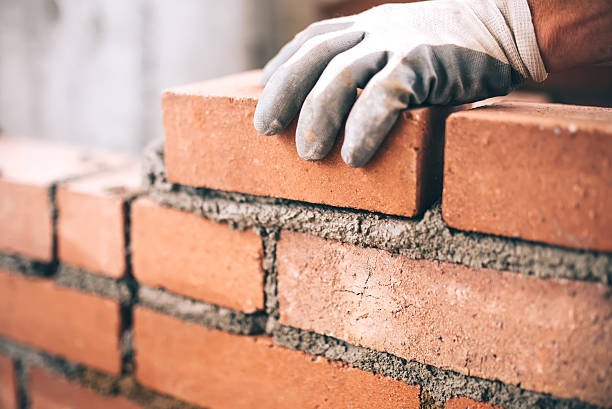Opening the Tricks of Sustainable Stonework Building And Construction Practices for Eco-Friendly Buildings
Amongst the myriad methods to environment-friendly structure, lasting masonry building and construction stands out as a time-tested and resilient technique that holds a riches of untapped potential. From the option of products to innovative construction methods, the keys to achieving sustainability within masonry construction are complex and appealing.
Advantages of Lasting Masonry Building
Accepting lasting masonry construction practices not only decreases ecological effect yet also offers long-lasting economic advantages to builders and areas. By utilizing products like recycled blocks, obstructs, and rocks, builders can considerably lower the carbon footprint of their projects while advertising resource performance. In addition, lasting masonry building methods, such as appropriate insulation and thermal mass properties, can enhance energy effectiveness within structures, bring about lowered functional costs with time.
In addition, the sturdiness and durability of masonry structures contribute to long-term economic benefits. Buildings built utilizing sustainable masonry practices usually call for much less maintenance and repair work, equating to cost savings for builders and homeowner. The durability of masonry products also ensures that frameworks stay steady and safe, lowering the need for regular remodellings or replacements.
Eco-Friendly Stonework Products
Using eco-friendly stonework products is a critical action in the direction of boosting the sustainability of building practices and reducing ecological influence while optimizing long-term economic advantages. Sustainable masonry products are sourced, generated, and utilized in a way that lowers general environmental influence. Products such as recycled blocks, redeemed stone, and lasting cinder block are coming to be significantly popular options for eco-conscious building contractors. Recycled blocks, for example, not just draw away waste from landfills however likewise need less energy to generate contrasted to new blocks. Redeemed rock offers a distinct aesthetic charm while lowering the demand for new quarrying. Sustainable concrete blocks include recycled aggregates and might include better insulation residential properties, adding to energy performance in structures.
In addition, natural materials like adobe, rammed planet, and straw bundles offer excellent thermal mass properties, decreasing the requirement for home heating and cooling down energy. These materials are often in your area readily available, promoting local economic situations and reducing transportation-related carbon emissions. By selecting green masonry products, building and construction projects can considerably reduce their environmental impact and add to the development of much healthier, more sustainable developed atmospheres.
Energy-Efficient Stonework Strategies
Energy performance plays a critical duty in enhancing the sustainability of masonry building and construction practices. By applying energy-efficient masonry strategies, builders can significantly decrease the total energy intake of a building, bring about lower operational costs and a smaller environmental kia used cars impact. One crucial energy-efficient stonework technique is making use of thermal mass, which entails including thick products like concrete or brick right into the building's structure to absorb and save warmth. This aids control indoor temperatures, decreasing the need for mechanical home heating and cooling systems.

Developments in Lasting Stonework
Recent advancements in sustainable stonework techniques have produced cutting-edge strategies that are reshaping the building and construction sector. One such development is the development of self-healing concrete, which utilizes microorganisms embedded within the concrete to heal cracks autonomously. This innovation not just minimizes upkeep prices yet also boosts the toughness of masonry structures, adding to their sustainability.
One more notable technology is making use of recycled accumulations in masonry building and construction - masonry contractor. By integrating products such as crushed ceramic waste or recycled glass into concrete blends, contractors can lower the environmental influence of building jobs while keeping architectural integrity. This method not just diverts waste from land fills however also saves natural deposits, making it a crucial innovation in sustainable masonry construction
Additionally, the assimilation of digital style devices, such as Structure Details Modeling (BIM), is revolutionizing the method masonry frameworks are intended and built. BIM enables more exact estimations, decreased material wastefulness, and improved power performance, inevitably leading to more lasting structure practices. These advancements jointly indicate an encouraging future for sustainable masonry building and construction in the era of environmentally friendly structures.
Future Trends in Stonework Sustainability
With the cutting-edge strides made in sustainable masonry practices, the future trends in masonry sustainability are poised to additional revolutionize the over here building and construction sector. One of the key patterns forming the future of stonework sustainability is the boosted combination of technology. Innovations such as Building Details Modeling (BIM) and virtual fact simulations are being used to optimize masonry building processes, causing decreased product waste and boosted energy performance her explanation in buildings.
Moreover, the advancement of unique sustainable products is set to play a considerable function in improving the eco-friendliness of masonry building and construction. masonry contractor. Advancements like self-healing concrete, recycled accumulations, and bio-based binders are gaining grip for their capability to decrease environmental effect while maintaining structural stability

Final Thought
In verdict, lasting masonry building practices offer countless advantages for environmentally friendly structures. By using green products and energy-efficient techniques, stonework can add to a more lasting constructed atmosphere. Advancements in sustainable masonry are continuously being developed to better enhance the ecological efficiency of structures. Looking in the direction of the future, the fad of masonry sustainability is anticipated to expand, leading to even more eco pleasant and energy-efficient construction techniques in the years to find.